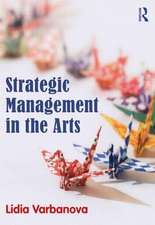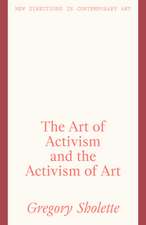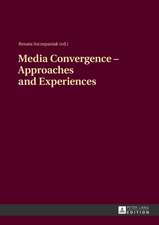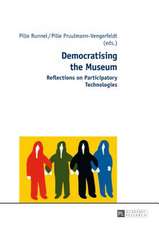Dark Matter: Art and Politics in the Age of Enterprise Culture: Marxism and Culture
Autor Gregory Sholetteen Limba Engleză Paperback – 4 noi 2010
Gregory Sholette, a politically engaged artist, argues that imagination and creativity in the art world originate thrive in the non-commercial sector shut off from prestigious galleries and champagne receptions. This broader creative culture feeds the mainstream with new forms and styles that can be commodified and used to sustain the few artists admitted into the elite.
This dependency, and the advent of inexpensive communication, audio and video technology, has allowed this 'dark matter' of the alternative art world to increasingly subvert the mainstream and intervene politically as both new and old forms of non-capitalist, public art. This book is essential for anyone interested in interventionist art, collectivism, and the political economy of the art world.
| Toate formatele și edițiile | Preț | Express |
|---|---|---|
| Paperback (1) | 211.74 lei 6-8 săpt. | |
| PLUTO PRESS – 4 noi 2010 | 211.74 lei 6-8 săpt. | |
| Hardback (1) | 649.55 lei 6-8 săpt. | |
| PLUTO PRESS – 4 noi 2010 | 649.55 lei 6-8 săpt. |
Preț: 211.74 lei
Nou
Puncte Express: 318
Preț estimativ în valută:
40.52€ • 42.15$ • 33.45£
40.52€ • 42.15$ • 33.45£
Carte tipărită la comandă
Livrare economică 14-28 aprilie
Preluare comenzi: 021 569.72.76
Specificații
ISBN-13: 9780745327525
ISBN-10: 0745327524
Pagini: 256
Ilustrații: 41 photographs
Dimensiuni: 150 x 230 x 18 mm
Greutate: 0.4 kg
Editura: PLUTO PRESS
Colecția Pluto Press
Seria Marxism and Culture
Locul publicării:United Kingdom
ISBN-10: 0745327524
Pagini: 256
Ilustrații: 41 photographs
Dimensiuni: 150 x 230 x 18 mm
Greutate: 0.4 kg
Editura: PLUTO PRESS
Colecția Pluto Press
Seria Marxism and Culture
Locul publicării:United Kingdom
Notă biografică
Gregory Sholette is an artist, activist and author based in New York. He co-founded two artists' collectives: Political Art Documentation and Distribution (1980-88) and REPOhistory (1989-2000). He is the author of Dark Matter: Art and Politics in the Age of Enterprise Culture (Pluto, 2010) and co-editor of Collectivism after Modernism: The Art of Social Imagination after 1945 (2007) and The Interventionists: Users' Manual for the Creative Disruption of Everyday Life (2004).
Cuprins
Exordium: An Accidental Remainder
(Sets the scene through a brief meditation on an all but forgotten artists’ collective that the author once belonged to: Political Art Documentation/Distribution aka PAD/D, and its missing presence in contemporary art history.)
Introduction: The Missing Mass
(Who is the author and how did this book come about followed by a concise description of each chapter in the volume.)
1 Art, Politics, Dark Matter: Nine Prologues
(An overview of the book’s key themes and arguments.)
2 The Grin of the Archive
(A critical journey into the PAD/D Archive that is now housed in the Museum of Modern Art is used to examine the shifting politics of the 1980s as neo-conservativism, economic deregulation, gentrification, and the remnants of the New Left clashed in New York City and elsewhere.)
3 History That Disturbs the Present
(Public art projects about history’s missing narratives produced by the artists’ group REPOhistory are described in relation to both the concept of the shadow archive, and in terms of the ultra-gentrified New York City of the 1990s.)
4 Temporary Services
(Chicago’s informal artists’ group Temporary Services is discussed and contrasted to what might be described as the rise of a dark matter Ressentiment exemplified by groups like the Minutemen Border Patrol vigilantes, and the Tea Party.)
5 Glut, Overproduction, Redundancy!
(A journey into the dark matter of the art world’s invisible political economy with its hidden dependency on the unremunerated productivity of the majority of artists.)
6 The Unnamable
(Why did Steve Kurtz and Critical Art Ensemble became a targets of the George Bush Department of Justice (sic), the answer put forth her is that the Tactical Media group not only operated collectively, but openly reverse-engineered power relations dear to the neo-liberal corporate state.)
7 Mockstitutions
(Art collectives, groups, and informal communities reinvent institutional form for the 21st Century by skeptically imitating the very function of institutional power.)
8 Conclusions: Nights of Amateurs
(So-called dark matter creativity is only the most recent expression of a far longer cultural history “from below”.)
Notes
Bibliography
Appendix: Artists’ Groups Survey 2008
Index
(Sets the scene through a brief meditation on an all but forgotten artists’ collective that the author once belonged to: Political Art Documentation/Distribution aka PAD/D, and its missing presence in contemporary art history.)
Introduction: The Missing Mass
(Who is the author and how did this book come about followed by a concise description of each chapter in the volume.)
1 Art, Politics, Dark Matter: Nine Prologues
(An overview of the book’s key themes and arguments.)
2 The Grin of the Archive
(A critical journey into the PAD/D Archive that is now housed in the Museum of Modern Art is used to examine the shifting politics of the 1980s as neo-conservativism, economic deregulation, gentrification, and the remnants of the New Left clashed in New York City and elsewhere.)
3 History That Disturbs the Present
(Public art projects about history’s missing narratives produced by the artists’ group REPOhistory are described in relation to both the concept of the shadow archive, and in terms of the ultra-gentrified New York City of the 1990s.)
4 Temporary Services
(Chicago’s informal artists’ group Temporary Services is discussed and contrasted to what might be described as the rise of a dark matter Ressentiment exemplified by groups like the Minutemen Border Patrol vigilantes, and the Tea Party.)
5 Glut, Overproduction, Redundancy!
(A journey into the dark matter of the art world’s invisible political economy with its hidden dependency on the unremunerated productivity of the majority of artists.)
6 The Unnamable
(Why did Steve Kurtz and Critical Art Ensemble became a targets of the George Bush Department of Justice (sic), the answer put forth her is that the Tactical Media group not only operated collectively, but openly reverse-engineered power relations dear to the neo-liberal corporate state.)
7 Mockstitutions
(Art collectives, groups, and informal communities reinvent institutional form for the 21st Century by skeptically imitating the very function of institutional power.)
8 Conclusions: Nights of Amateurs
(So-called dark matter creativity is only the most recent expression of a far longer cultural history “from below”.)
Notes
Bibliography
Appendix: Artists’ Groups Survey 2008
Index
Recenzii
“Masterfully illuminates the configurations, ideas, and behaviors of collectives dedicated to cultural resistance. Dark Matter is essential reading for anyone concerned with the fate of the avant-garde and the emergence of new possibilities in cultural production that suggest and create alternatives to global capitalism."
“With great verve and urgency, Sholette explores the economics of contemporary art production in an era of neoliberalism, and outlines the promises and pitfalls of various tactics of resistance. Dark Matter is a salient call-to-arms to all cultural laborers."
“An important and necessary intervention. Dark Matter is well-placed to shift the debate on art's utility back within the domain of labor and value, where it has long been missing.”
“Focusing primarily on the anti-institutional, collective, and politically critical artists that often willingly reject the light of the mainstream galleries and academies, Sholette both highlights a vast array of important contributors to art of the last decade and also challenges the ahistorical assumptions that ground the capitalist art market.”
“As both active participant and witness, Sholette sheds a welcome and overdue light on the dark matter of the so-called art world.”
“Dark Matter is the ultimate companion to contemporary activist art. In his exquisite and theoretically informed style, Sholette investigates the problematic functions of art practices in the processes of neoliberal appropriation, but above all the wild, explosive and deterritorializing lines that are drawn in the dark matter between art and politics.”





























